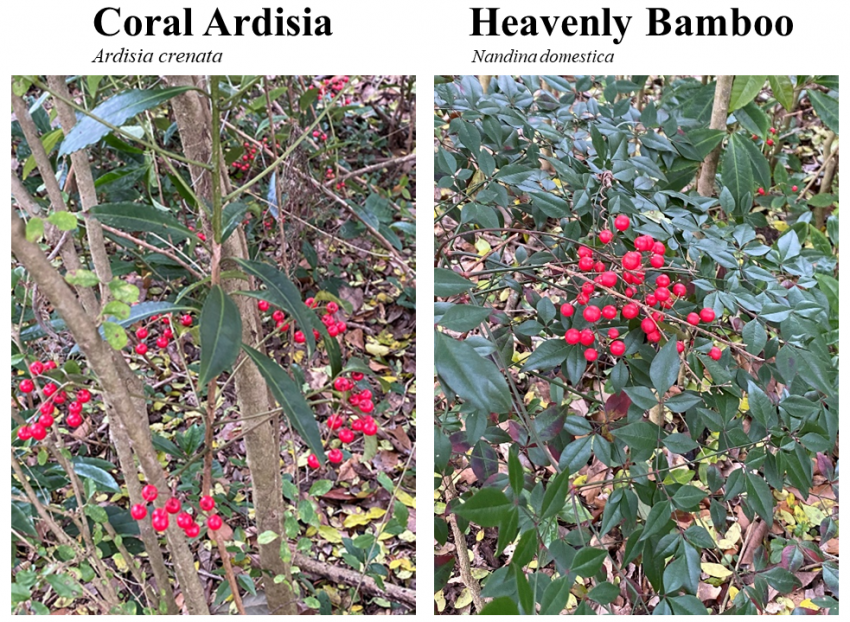Ann Blount, UF/IFAS Forage Extension Specialist, João Bittar, UF/CVM Extension Beef Veterinarian, Adam Stern-UF/CVM Veterinary Forensic Pathologist, and Evie Blount, UF/IFAS Extension Gadsden County 4-H Agent
–
Livestock producers beware! Especially during the winter months, hungry livestock may be tempted to graze on plants that are toxic. While we recognize many of these plants, like black nightshade, lantana, crotalaria and coffee weed or coffee senna, not all plants are listed in our publications as potential sources for livestock poisoning. Some plants, often ornamental landscape plants, have escaped into the wild and are proliferating and naturalizing in open pastures and shaded, wooded areas where livestock may graze.
–

Coral ardisia or Ardisia crenata (left) and Heavenly bamboo or Nandina domestica found in a wooded pasture in Gadsden County, FL on January 24, 2021 and are suspected in cattle poisoning and subsequent death from grazing. Credit: Ann Blount, UF/IFAS
–
In Gadsden County, consumption of Coral Ardisia (Ardisia crenata) and Heavenly Bamboo (Nandina domestica) are suspected of causing cattle deaths. Cattle were recently turned out into a wooded pasture where these plants were heavy with ripe berries. Clinical signs observed in these cattle included abdominal distention (acute bloat), impaction (slowed gut motility), and death. While Nandina species have been identified as highly toxic to livestock in veterinary journals, poisoning from Coral Ardisia consumption has not been confirmed.
Although these plants have been implicated as toxic to livestock in Florida in two similar situations, no actual proof of causation was determined. Often there are reports about healthy livestock of various species and ages dying from an unexplainable circumstance. The cause of the livestock illness or deaths are not typically investigated, due to the costs associated with veterinary expertise, timely necropsies, collections and submissions.
In this particular situation, the UF/IFAS Extension Gadsden County Office was contacted. University Specialists were asked to investigate the actual cause of the illness and death of these cattle. The cattle were immediately removed from the wooded pasture area where they exhibited health issues and were placed in a clean pasture with available sources of fresh water, clean hay and mineral. The wooded area, where they had been grazing, was checked for potential poisoning sources. All feed-stuffs that the animals were consuming were sampled for mold. A local veterinarian examined several bloated animals and concluded that they suffered from impaction, due to slow gut motility, but did not pursue additional testing to determine the cause of the bloat. Even ten days after the herd was moved to a clean pasture area, the mortality rate reached 47%, which is exceptionally high, with catastrophic consequences for the rancher.
Consequently, Dr. Joao Bittar, UF/CVM-Beef Cattle Extension Veterinarian, Dr. Adam Stern, UF/CVM Veterinary Forensic Pathologist, and Dr. Ann Blount, UF/IFAS Forage Extension Specialist worked with Evie Blount , Gadsden County 4-H agent, and the owner of the livestock to identify the potential cause of the illness and deaths. Plant specimens, including fresh leaves and berries of both plants, and various animal organs, rumen contents and blood samples were sent to Iowa State University’s Veterinary Diagnostics Laboratory in Ames Iowa. In an effort to confirm the cause of the animal illness, these steps were taken quickly, since the timing of the samples and their perishable nature was critical for proper diagnoses. Additionally, whole plants of Coral Ardisia and Heavenly bamboo were sent to Marc Frank at the UF/IFAS Herbarium for positive identification.
When an event like this occurs with livestock, immediately remove animals to a secure and safe area. Contact your local veterinarian, your State Animal Health inspectors, and local county agent. By asking for their assistance, you may be able to determine and prevent more unnecessary livestock losses. Also, it can help educate others about potential pitfalls, especially from non-native invasive plants that have yet to be evaluated for their toxic properties.
–
For more information on common poisonous pasture weeds, use the following link:
Poisonous Plants of the Southern United States
- Cool-Season Forages – A Pasture Perspective for 2022 - September 16, 2022
- Ornamental Rhizoma Perennial Peanut for Groundcover or Alternative Turf - March 18, 2022
- 2021 Cool-Season Forage Recommendations for Livestock and Wildlife - September 24, 2021
